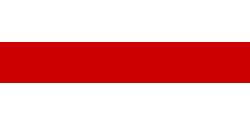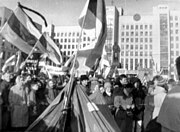Belarusian nationalism
The neutrality of this article is disputed. (September 2020) |

Belarusian nationalism is the nationalism that asserts the nationality of Belarusians.[1] Belarusian nationalism began only in the 20th century's first decade.[2] Although the Belarusian People's Republic, declared on 25 March 1918, was the first manifestation of Belarusian statehood, Belarusian nationalists claimed that the Lithuanians that created the Grand Duchy of Lithuania were actually Belarusians.[2] The pseudohistorical theory that Belarusians created the Grand Duchy of Lithuania is called Litvinism.[3]
Many Belarusian nationalists, especially the BPF Party and Rada of the Belarusian Democratic Republic claim a large part of Lithuania (Vilnius County) as well as large parts of Russia (Smolensk Oblast and Bryansk Oblast), Latvia (Daugavpils district, Daugavpils and Krāslava District) and Poland (Podlaskie Voivodeship).[4][5][6] Moreover, Belarusian nationalists claim that Lithuania is actually Samogitia (Belarusian: Zhamojc).[4]
Interwar[]
The Belarusian People's Republic, established in 1918, was occupied by communist Russia that same year, with its claimed territories later split between Polish and Russian occupiers into Western and Eastern Belorussia following the Polish–Soviet War.[4][7]

Belarusian national white-red-white flag on a house of National Secretariat of Belarusian People's Republic, (Minsk, 1918)

Third charter of Belarusian People's Republic (Minsk, 1918)

Government of Belarusian People's Republic (Minsk, 1918)

Belarusian housars in front of the house of Tribunal in Hrodna (1919)
World War II[]
Belarusian nationalism was endorsed by the German occupiers of Byelorussia during World War II.[8]
Post-Soviet era[]
On 25 August 1991, the independent Republic of Belarus was proclaimed.[4]

Anti-communist rally organized by Belarusian Popular Front (Minsk, 1990)

Anti-communist rally organized by Belarusian Popular Front (Minsk, 1990)
Current Nationalist organizations[]
Today there are several organizations with the ideological basis of Belarusian nationalism, including the BPF Party, the CCP BPF, Young Front and the Right Alliance. However, since the 2000s, Belarusian nationalism, where nationalists opposed the government of Alexander Lukashenko, has declined with few nationalist organizations currently existing.[citation needed] Lukashenko during his time as president has been described as anti-nationalist.[citation needed] The once prominent nationalist politician, Zianon Pazniak, has been described as authoritarian and politically radical and was blamed as one of the reasons for the opposition's defeat in the 1990s.[9]

Following the Russo-Ukrainian War in 2014, a number of Belarusian nationalists fought along Ukrainian government troops.[10][11][12] The Monument to the Belarusians who died for Ukraine was opened on 28 March 2016 in Kyiv, Ukraine's capital.[13]

Opposition Protests (Minsk, 2006)

Celebrating the 100th anniversary of the Belarusian People's Republic (Minsk, 2018)
Literature[]
- Krushinsky S. Byelorussian Communism and Nationalism: Personal Recollections. New York, 1953.
- Vakar N. P. Belorussia. The Making of Nation. Cambridge, Massachusetts, 1956.
- Bulhakau V. The History of Belarusan Nationalism. Vilnya, 2007. [Валер Булгакаў. Гісторыя беларускага нацыяналізму. — Вільня: Інстытут беларусістыкі, 2007. — 331 с. (in Belarusian)]
- Marples D. R. Belarus: A Denationalized Nation. Abingdon, Routledge, 2013.
- Rudling P. A. The Rise and Fall of Belarusian Nationalism, 1906–1931. University of Pittsburgh Press, 2014.
- Hroch M. European Nations: Explaining their Formation. London, 2015.
- Fabrykant M. Russian-speaking Belarusian Nationalism: An Ethnolinguistic Identity Without a Language?, Europe-Asia Studies, 2019.
- Rudling, Per Anders (5 December 2017). ""Unhappy Is the Person Who Has No Motherland": National Ideology and History Writing in Lukashenka's Belarus". War and Memory in Russia, Ukraine and Belarus. Springer International Publishing. pp. 71–105. ISBN 978-3-319-66523-8.
See also[]
- Belarusian national revival
- Litvinism
- Kastus Kalinouski
- Zianon Pazniak
References[]
- ^ Zaprudnik, Jan; Silitski, Jr., Vitali (2010). The A to Z of Belarus. Scarecrow Press. p. 45. ISBN 9781461731740.
- ^ a b Motyl, Alexander J. (2000). Encyclopedia of Nationalism, Two-Volume Set. Academic Press. pp. 44–45. ISBN 9780080545240.
- ^ Bakaitė, Jurga (27 December 2011). "LRT FAKTAI. Ar lietuviams reikia bijoti baltarusių nacionalinio atgimimo?" (in Lithuanian). Lithuanian National Radio and Television.
- ^ a b c d Pazniak, Zianon (16 August 2004). "BELARUS IS AN EASTERN OUTPOST". New York.
{{cite journal}}: Cite journal requires|journal=(help) - ^ Dawisha, Karen; Starr, S. Frederick (1994). National Identity and Ethnicity in Russia and the New States of Eurasia. p. 165. ISBN 9781563243547.
- ^ Pancerovas, Dovydas. "Ar perrašinėjamos istorijos pasakų įkvėpta Baltarusija gali kėsintis į Rytų Lietuvą?". 15min.lt (in Lithuanian). Retrieved 1 October 2014.
- ^ (9 December 2013). Belarusian Identity: the Impact of Lukashenka's Rule (PDF). Minsk-London: Ostrogorski Centre.
{{cite book}}: CS1 maint: date and year (link) - ^ Ioffe, Grigory (29 August 2019). "For the Sake of a Brighter Future, Belarusians Argue about the Past". Archived from the original on 13 April 2021.
- ^ Is There Nationalism in Belarus? // BelarusDigest, 5 March 2013
- ^ Belarusian ‘Vayar’ vs. ‘Black Hundred’ // InformNapalm
- ^ Belarusians are fighting in Avdeevka? // WeapoNews.com
- ^ Belarus Slowly and Carefully Walks Along the Ukrainian Path // stalkerzone.org
- ^ Monument to Belarusians who died for Ukraine was opened in Kyiv // Belsat TV
- Belarusian nationalism







